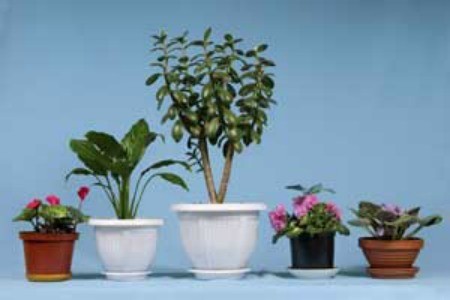
Summer break is almost over for tender perennials and houseplants that have been vacationing on the patio. With cooler weather starting to move in, it's time to start preparing them for the big move back indoors. From a plant's perspective, a move of only a few feet can be potentially stressful-in some cases, even deadly. To keep your plants healthy going into winter, you need to reintroduce them to indoor conditions in the same way you introduced them to the conditions outdoors-gradually.
To plants that have spent all summer in an outdoor environment, an abrupt move indoors is akin to stepping off a spaceship onto another planet. To avoid stressing them (or worse), try to prepare plants for their new environmental conditions by acclimating them over a period of a few weeks before moving them completely inside. This is called reverse hardening. In the same way you harden off a plant before moving it outdoors, reverse hardening accomplishes the same process for the move back indoors. If seasonal changes cause you to bring your plants indoors before they've had enough time to adapt, use a transitional zone between your indoor and outdoor space (e.g. garage, porch, or basement) to finish the reverse hardening off process.
Before moving your plants indoors, inspect them carefully for insects-especially those that have been sitting in pots on the ground. It is much easier to treat insect problems while plants are still outdoors, and you don't want to risk introducing any headaches to the rest of your otherwise healthy indoor plants. As an extra precaution, lift plants out of their pots to detect whether any pests have crawled in through drainage holes in the bottom.
It's impossible to mimic the intensity of outdoor sunlight indoors, but we can try. To acclimate plants to weaker indoor light conditions, gradually reduce their light levels while they're still outdoors. If they've been growing in full sun, move them to partial shade for a for part of the day, gradually moving them to full shade and finally indoors. Once inside, try to duplicate their preferred outdoors light conditions with as much natural light as possible.
Most plants need less water and fertilizer in the winter because their growth tends to slow down in response to the lower light and temperature conditions. Water plants weekly or when the soil becomes dry to the touch. Unless the plant is showing a lot of new growth, it isn't necessary to keep fertilizing. This is especially true if the plant has been recently repotted. Plants kept growing vigorously by means of artificial lights should be given a water soluble fertilizer monthly and watered more frequently.
With the exception of succulents that hail from arid environments, indoor air is much too dry in the winter for most plants. Keep plants away from heating vents and fireplaces and mist them regularly to prevent leaves from drying out. Groups plants together on waterproof trays filled with small pebbles and water to help keep the surrounding air humid as the water evaporates.
If plants have outgrown their present containers (roots coming out of drainage holes), or the soil has become hard or encrusted with salt residue, now is a good time for repotting. Tall leggy plants should be removed from their pots and their crowns and roots trimmed in equal proportions. Old pots should be scrubbed clean and the soil replaced with a sterilized commercial potting soil. New containers should be only 1-2 sizes larger than the previously outgrown containers.
Many tender plants risk serious injury from the cold when nighttime temperatures drop below 45º F and most tropical plants below 40ºF. Because weather is unpredictable, it's best to play it safe. When temperatures start to drop below 50ºF for more than a few hours each day, it's probably best to move plants indoors. Other plants, like orchids, should be moved indoors when temperatures start reaching the 55ºF-60ºF range.

About The Author: Ellen Brown is an environmental writer and photographer and the owner of Sustainable Media, an environmental media company that specializes in helping businesses and organizations promote eco-friendly products and services. Contact her on the web at http://www.sustainable-media.com
Add your voice! Click below to comment. ThriftyFun is powered by your wisdom!